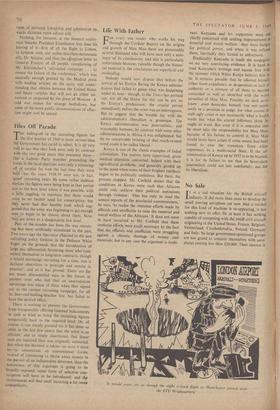No Sale
IT is a sad situation for the British aircraft industry. It did more than most to develop the small touring aeroplane yet now that a market for this kind of machine Is re-appearing, it has nothing new to offer. Or at least it has nothing capable of competing with the'sinall civil aircraft originating in the United'States, France, Belgium, Switzerland, Czechoslovakia, Poland, Germany and Italy. Its large government-sponsored groups are too grand to 'concern themselves with aero- planes costing less than £20,000. Their interest is in monsters, in supersonic liners, in replacements for the 707 and the DC8, in the aerodynamically tortured projects of BEA and of BOAC. Meanwhile the signs point unmistakably to the rapid growth of a useful European and Austral- asian market for small civil aircraft. Companies. clubs and individuals are ready to pay fair prices for up-to-date aeroplares. There is a demand and there is a supply. but it is not a British supply.
A report prepared by an engineer after three Years' work and the collaboration of a world- Wide service organisation, ranging over forty- four countries, gives details of 82,057 light air- craft. Of these 65,312 are in the American CAA Register, leaving 16.745 This represents the sur- prisingly high proportion of 87 per cent. of all civil aircraft, including those of the scheduled airlines. Of the grand total of light aircraft 19 per cent. were built in this country. most of them now of obsolete design and out of production. And the serious thing is that British manufac- turers will be unable to play any substantial part to the large number of replacements .which will soon be due. These, figures. by the way. take no count of military light aircraft and these, outside the 'United States and the iron curtain countries. number more than 12,000.
Although new models are being produced, in France, Italy, Switzerland and Germany, no com- Parable new models are being produced here., One new British civil light aircraft of outstanding Promise, based on extensive wind-tunnel work and certainly capable of competing with the best United States machines at a lower price, had reached the design stage a short time- ago. It has- .now been abandoned by its manufacturing com- Pany which is more concerned with the organisa- tional activities of Mr. Duncan Sandys than with the tedious and risky work of light aircraft development. There is, however, a slender chance that this admirable . design will .be taken up by an independent company: Apart from this it is already difficult to see how the British industry, even if it suddenly evinced an interest in the matter, could make up for lost time. The market report referred to above Says that we are 'now losing markets which it may be impossible to re-enter in five to ten years' time.' The purchase of manufacturing licences is the usual method of time-saving and is already being practised to a small extent. The building of foreign-designed aircraft may not be wholly satisfactory,, but it takes three years to develop an original light aircraft design. On the engine side there would have to be construction under licence for a time.
Britain has had good light aircraft engines bat, apart from the Blackburn turbines which were originally of French design, the presently avail- able engines differ markedly from the kinds favoured in other countries. The 'flat' four or six with fuel injection is becoming firmly established. The Bristol Cherub (a twin) of the early Lympne competitions and another engine designed later by Sir Roy Fedden were of the 'flat' variety and the Fedden engine had fuel injection; but neither type was thought to be worth continued develop- ment.
Financially the production of light civil air- craft can never be so rewarding as the production of military machines- or large airliners. But market research indicates that the commercial prospects are fairly gooa. In the five years from the date of the report the predicted demand out- side the United States and the iron curtain coun- tries is for 11,000 civil light aircraft and prob- ably 6,000 military light aircraft. Considerable expansion is predicted for the following five to ten years. In France ten firms are turning out twelve different types of modern light utility air- craft for flying Clubs and business and purposes; in Italy eight firms are producinn four- teen different types. But apart from the de land Dove, the British export market is in the hands of one firm, Auster.
From many points of view it will be a pity if, with the consortia of the aircraft industry absorbed in their many-million‘d problems, no one is left to pay any attention to British civil light aircraft.



































 Previous page
Previous page